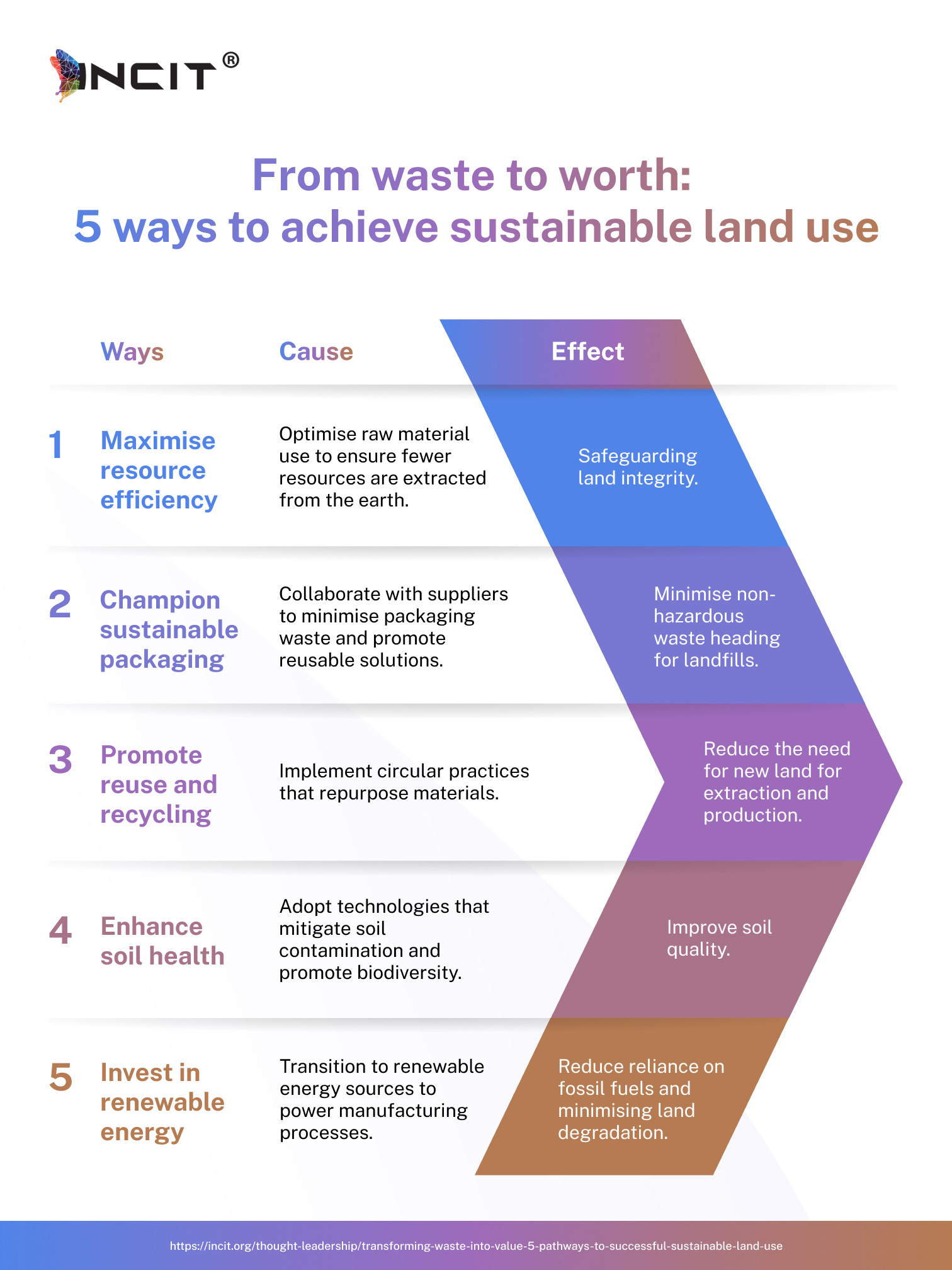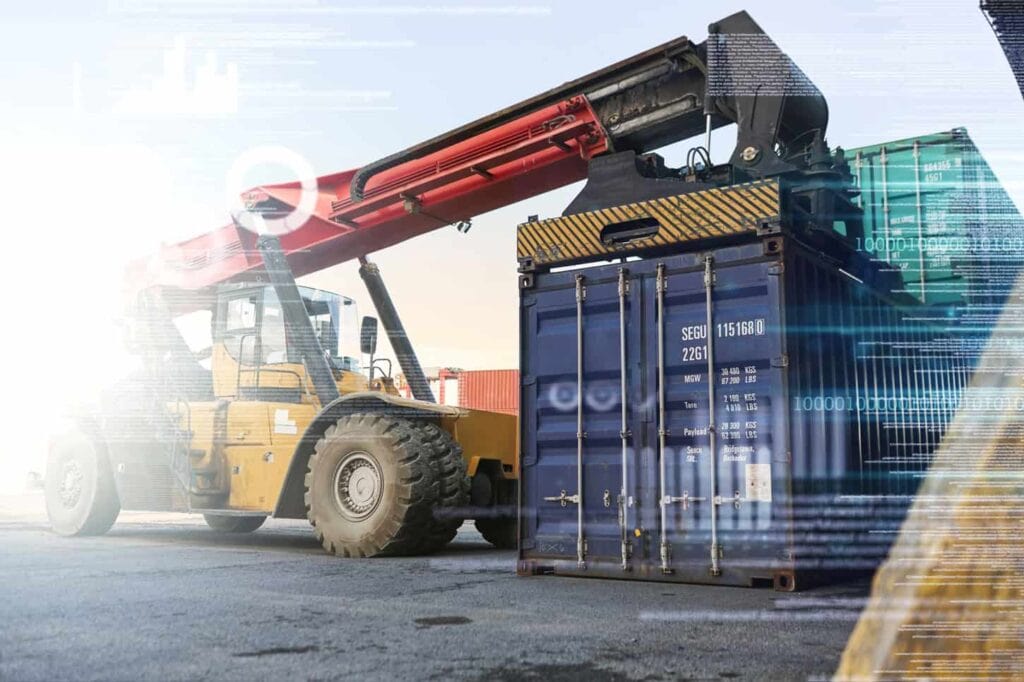Өндіріс бүкіл әлем бойынша ластаудың ең үлкен көздерінің бірі болып табылады және өнімге тұтынушылық сұраныстың өсуі жалғасуда бұл өзгеріске ұшырауы екіталай. Өнеркәсіптік процестер, әсіресе тау-кен өнеркәсібі мен өңдеу өнеркәсібіндегі, тарихта топырақтың ластануына негізгі үлес қосты және фармацевтикалық препараттарды қоспағанда, химиялық заттарды пайдалану 2030 жылға қарай 85 пайызға артады деп болжануда. Дегенмен, өндірушілер климатқа қатысты әрекетке келгенде бос қалмауы керек. Олар қалдықтарды азайту және жерді тұрақты пайдалануды ынталандыруда белсенді рөл атқаруы керек. Қалдықтарды азайту арқылы қауымдастықтар жақсырақ қорғалады және ластануды азайтатын және табиғи экожүйелерді сақтайтын іс-шаралармен аймақтың экологиялық денсаулығын жақсартуға жетекшілік ететін кәсіпорындардың теріс әсерін тигізбейді.
Өндірушілер жетекші рөлді қалай ала алады? Біріншіден, олар қайта өңдеуден, компосттаудан және жауапты тұтынудан бастап қалдықтарды азайту арқылы экологиялық іздерін азайтып, жерді тұрақты пайдалана алады. McKinsey & Co компаниясының мәліметінше, адамзаттың азық-түлік пен отынға деген қажеттіліктерін қанағаттандыру үшін әлемге қосымша 70-80 миллион гектар жер қажет. Бұл өмір сүруге жарамды жер қайдан келеді? Бұл барлық адамдар үшін проблема болғанымен, өндірушілер жерді тұрақты пайдаланудың берік іргетасын тез арада құру және басқа секторлар үшін эталон орнату үшін жылдам әрекет етуі керек.
Жауапкершілікпен жерді басқару және жерді қалпына келтіру тәсілі үшін қалдықтарды азайту, өнімді қайта пайдалануды ынталандыру және ресурс тиімділігін оңтайландыру сияқты жасыл өндіріс әдістерін қалай қабылдауға және айналмалы экономика принциптерін қабылдауға болады.

Бұл тәжірибелерді тиімді жүзеге асыру үшін мыналарға сүйеніңіз Тұтынушылық тұрақтылық индустриясының дайындығы индексі (COSIRI), цех алаңы, жеткізу тізбегі, логистика, стратегия және тәуекелдер сияқты негізгі салаларда тұрақты дамудың жетілуін бағалау үшін кеңінен танылған құрылым. Ол бас директорларға стратегиялық шешімдер қабылдау үшін маңызды түсініктерді береді, операцияларда тұрақты тәжірибені алға жылжытады. Бизнеске айтарлықтай әсер етуге дайынсыз ба? INCIT ұйымыңызды жерді пайдалану тәжірибесін жақсартуға әкелетін тұрақты операцияларға қолдау көрсете отырып, сіздің сарапшы нұсқаулығыңыз ретінде қалай әрекет ететіні туралы көбірек біліңіз. бізбен байланысады.
Өндірісте жерді тұрақты пайдалану стратегиялары туралы жиі қойылатын сұрақтар
Өндірісте жерді тұрақты пайдалану дегеніміз не?
Өндірісте жерді тұрақты пайдалану қоршаған ортаға әсерді азайту, қалдықтарды азайту және экономикалық өсу мен қоғамның әл-ауқатын қолдай отырып, ұзақ мерзімді ресурстардың тиімділігін арттыру үшін өнеркәсіптік жерлерді жоспарлауды және басқаруды қамтиды.
Өнеркәсіптік жер пайдалануда қалдықтарды қалай құндылыққа айналдыруға болады?
Қалдықтарды материалдарды қайта өңдеу, қоңыр алқаптарды қалпына келтіру, жанама өнімдерді энергияға немесе құрылысқа пайдалану және аумақты дамытуға айналмалы экономика принциптерін біріктіру арқылы өнеркәсіптік жер пайдаланудағы құндылыққа айналдыруға болады.
Өндірушілер үшін жерді тұрақты пайдаланудың қандай пайдасы бар?
Тұрақты жерді пайдалану өндірушілерге экологиялық тәуекелдерді азайтуға, операциялық шығындарды азайтуға, ESG стандарттарына сәйкестікті жақсартуға, бренд беделін арттыруға және қалдықтардан құнды инновациялар арқылы жаңа кірістерді ашуға көмектеседі.
Жерді пайдалануды жоспарлау экологиялық тұрақтылықты қалай қолдайды?
Жерді пайдалануды жоспарлау тіршілік ету ортасының бұзылуын азайту, ресурстарды тиімді басқару, топырақ пен судың ластануын болдырмау және бар өнеркәсіп орындарын қайта пайдалануға мүмкіндік беру арқылы экологиялық тұрақтылықты қолдайды.
Жерді тұрақты пайдаланудағы айналмалы экономиканың рөлі қандай?
Дөңгелек экономика материалды қайта пайдалануды ынталандыру, қалдықтарды азайту және жер, ресурстар мен инфрақұрылым ұзақ мерзімді пайдалану үшін оңтайландырылған жабық жүйені ынталандыру арқылы тұрақты жер пайдалануда маңызды рөл атқарады.
Өндірістегі қалдықтардан құндылыққа айналдыру стратегияларының мысалдары қандай?
Мысалдарға энергия өндіру үшін өндірістің жанама өнімдерін пайдалану, өнеркәсіп қалдықтарын басқа процестер үшін шикізатқа айналдыру және жасыл кеңістіктер немесе жаңартылатын энергия қондырғылары үшін жерді қалпына келтіру жатады.
Браунфилд сайттарын орнықты пайдалану үшін қалай өзгертуге болады?
Браунфилд алаңдарын топырақты рекультивациялау, инфрақұрылымды жаңарту және тұрақты дизайн принциптерін біріктіру, пайдаланылмаған немесе ластанған жерлерді өнімді, экологиялық таза өнеркәсіптік немесе қоғамдық активтерге айналдыру арқылы өзгертуге болады.
Жерді тұрақты пайдалану Esg мақсаттарына қалай ықпал етеді?
Тұрақты жер пайдалану қоршаған ортаға әсерді азайту (E), жауапты даму (S) арқылы жергілікті қауымдастықтарды қолдау және жерді басқаруды ашық басқару тәжірибесімен (G) сәйкестендіру арқылы ESG мақсаттарына ықпал етеді.
Жерді тұрақты пайдалану стратегияларын жүзеге асыруда компаниялар қандай қиындықтарға тап болады?
Қиындықтарға қалпына келтіруге жоғары шығындар, нормативтік күрделілік, техникалық сараптаманың жоқтығы, мүдделі тараптардың қарсылығы және тұрақты материалдарға қол жеткізудің шектеулілігі немесе сайтты қайта құруды қаржыландыру нұсқалары кіреді.


